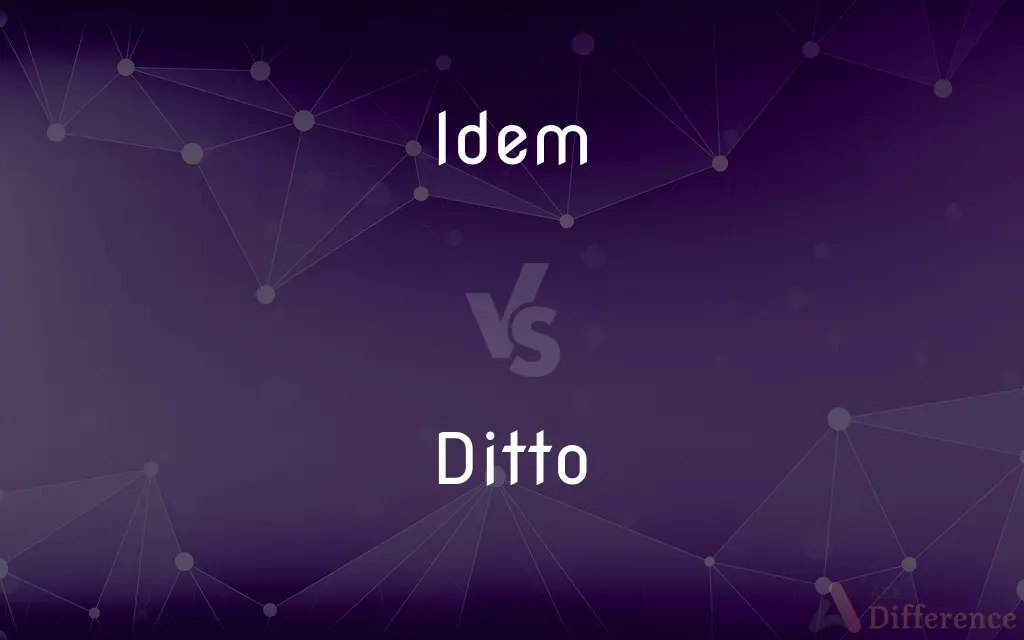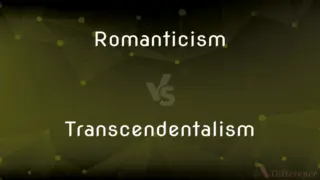Idem vs. Ditto — What's the Difference?
By Fiza Rafique & Maham Liaqat — Updated on March 28, 2024
"Idem" is a Latin term meaning "the same," used in scholarly works to cite a previously mentioned source, whereas "ditto" is a common term indicating a repetition of the previously stated item, often used in everyday language and lists.

Difference Between Idem and Ditto
Table of Contents
ADVERTISEMENT
Key Differences
"Idem" is primarily used in academic, legal, and bibliographic contexts to refer to the same author or source cited immediately before. This term helps streamline citations and references, maintaining a formal tone within scholarly documents. On the other hand, "ditto" is more informal and versatile, used not only in written documents to signify that the information is the same as the line or entry above but also in spoken language to express agreement or that something is exactly the same as what has been mentioned.
In academic writing, "idem" signifies a level of precision and formality, aligning with the structured and often rigorous nature of scholarly discourse. It is part of a specific vocabulary that disciplines such as law and academia adopt to ensure clarity and brevity in citations. Conversely, "ditto" is colloquial and finds its use in a variety of settings, from everyday conversations to business inventories, where it efficiently communicates repetition without the need for reiteration.
The use of "idem" requires a certain familiarity with academic or legal conventions, where understanding the context is key to interpreting its use correctly. "Ditto," however, is widely recognized and requires little to no specialized knowledge to understand, making it accessible to a broader audience.
While "idem" is restricted to indicating a repeated source or author, "ditto" can replicate any previously mentioned information, including names, dates, descriptions, and more. This flexibility makes "ditto" a handy tool in numerous written materials, such as menus, lists, and records, where space or time is limited.
The origin of "idem" from Latin speaks to its longstanding use in formal, educated, and institutional writing, reflecting the historical influence of Latin on academic and legal languages. "Ditto," originating from the Italian "detto," meaning "said," has a more populist and practical application, embodying a straightforward approach to indicating repetition across diverse languages and contexts.
ADVERTISEMENT
Comparison Chart
Meaning
"The same" in Latin, used for citing the same source
Indicates repetition of a previously stated item
Usage Context
Academic, legal, bibliographic
Everyday language, lists, documents
Tone
Formal
Informal
Purpose
Streamline citations
Communicate repetition efficiently
Applicability
Specific to citing authors or sources
Versatile, used for any repeated information
Audience
Academics, legal professionals
General public
Language Origin
Latin
Italian (from "detto")
Compare with Definitions
Idem
Employed in scholarly articles to streamline references.
See idem, page 24 for further discussion.
Ditto
Simplifies lists and tables by repeating information without rewriting.
Item 1: $5, Item 2: ditto.
Idem
A citation term used to refer to the same author or work as previously mentioned.
Smith, John. Book Title. City: Publisher, Year. Idem.
Ditto
Found in both written and spoken language for clarity and brevity.
For the office supplies order: pens, 100 units; pencils, ditto.
Idem
Common in legal documents to reference previously cited statutes or cases.
Refer to idem in paragraph 3 for legal precedent.
Ditto
Used to indicate that something already mentioned applies again.
The price for March is $20, April, ditto.
Idem
Indicates continuity in authorship in bibliographies.
Idem is used to avoid repetition of the author's name in consecutive citations.
Ditto
Represents the same or identical thing in casual conversation.
She's as excited as I am about the trip. Ditto for me.
Idem
Reflects a formal approach to academic writing.
Utilizing idem enhances the readability of scholarly works by reducing redundancy.
Ditto
Expresses agreement with someone else's statement.
I think this idea will work. Ditto!
Idem
Idem is a Latin term meaning "the same". It is commonly abbreviated as id., which is particularly used in legal citations to denote the previously cited source (compare ibid.).
Ditto
The same as stated above or before.
Idem
Used in citations to indicate an author or word that has just been mentioned
Marianne Elliott, Partners in Revolution, 1982; idem, Wolfe Tone, 1989
Ditto
A duplicate; a copy.
Idem
The same.
Ditto
A pair of small marks ( " ) used to indicate that the word, phrase, or figure given above is to be repeated.
Idem
The same; the same as above; - often abbreviated id.
Ditto
As before.
Ditto
To duplicate (a document, for example).
Ditto
That which was stated before, the aforesaid, the above, the same, likewise.
Ditto
A duplicate or copy of a document, particularly one created by a spirit duplicator.
Please run off twenty-four dittos of this assignment, for my students.
Ditto
(by extension) A copy; an imitation.
Ditto
The ditto mark, 〃; a symbol, represented by two apostrophes, inverted commas, or quotation marks (" "), indicating that the item preceding is to be repeated.
Ditto
A suit of clothes of the same colour throughout.
Ditto
As said before, likewise.
Ditto
(transitive) To repeat the aforesaid, the earlier action etc.
Ditto
(US) To make a copy using a ditto machine.
Ditto
Used as an expression of agreement with what another person has said, or to indicate that what they have said equally applies to the person being addressed.
I'm really busy today! —Ditto!
Ditto
The aforesaid thing; the same (as before). Often contracted to do., or to two "turned commas" ("), or small marks. Used in bills, books of account, tables of names, etc., to save repetition.
A spacious table in the center, and a variety of smaller dittos in the corners.
Ditto
As before, or aforesaid; in the same manner; also.
Ditto
A mark used to indicate the word above it should be repeated
Ditto
Repeat an action or statement;
The next speaker dittoed her argument
Common Curiosities
What is the primary difference between "idem" and "ditto"?
"Idem" is a formal term used in scholarly writing to cite the same source again, while "ditto" is an informal term used to indicate that something is the same as previously mentioned.
Can "idem" be used in informal settings?
While it's primarily used in formal contexts, "idem" could be understood in informal settings but is generally reserved for academic or legal writing.
How does "idem" streamline academic citations?
"Idem" streamlines academic citations by allowing authors to refer back to a previously cited work without repeating the full citation, saving space and avoiding redundancy.
What does the use of "idem" indicate about a writer?
The use of "idem" indicates that the writer is familiar with formal citation practices, likely within academic or legal contexts.
How does the flexibility of "ditto" benefit its use?
The flexibility of "ditto" allows it to be used in various contexts to efficiently indicate repetition of any kind of information, from prices to descriptions.
Is "ditto" appropriate for academic writing?
"Ditto" is typically considered too informal for academic writing, where more precise terms like "idem" or explicit citations are preferred.
Why might someone choose to use "ditto" in conversation?
Someone might use "ditto" in conversation to quickly express agreement or confirm that the same information or sentiment applies, without having to repeat what was just said.
Can "ditto" be used in official documents?
"Ditto" can be used in some official documents like inventories or lists to denote repetition, but its appropriateness depends on the formality required by the document.
Are there modern alternatives to using "idem" in citations?
Modern citation styles often have specific rules that may replace "idem" with author-date systems or use abbreviations like "ibid." for the same purpose.
How do "idem" and "ditto" reflect different approaches to communication?
"Idem" reflects a formal, academic approach emphasizing precision and adherence to tradition, whereas "ditto" embodies a more informal, versatile method of indicating repetition across diverse contexts.
Share Your Discovery

Previous Comparison
Romanticism vs. Transcendentalism
Next Comparison
Leasable vs. LeaseableAuthor Spotlight
Written by
Fiza RafiqueFiza Rafique is a skilled content writer at AskDifference.com, where she meticulously refines and enhances written pieces. Drawing from her vast editorial expertise, Fiza ensures clarity, accuracy, and precision in every article. Passionate about language, she continually seeks to elevate the quality of content for readers worldwide.
Co-written by
Maham Liaqat












































